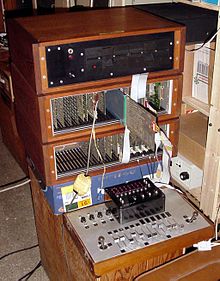Synclavier

The Synclavier System was an early digital synthesizer and sampler, manufactured by New England Digital. First released in 1975, it proved to be highly influential among both music producers and electronic musicians, due to its versatility, its cutting-edge technology and distinctive sound.
First developed at Dartmouth College, the Synclavier was one of the first synthesizers to completely integrate digital technology. It used FM synthesis as well as sampling in order to create sounds, which were stored on large, magnetic disks. It was often referred to, by New England Digital and others, as the "tapeless studio," due to one's ability to compose and produce an entire song, solely on the Synclavier. Synclavier Systems were expensive - the highest price ever paid for one was about $500,000, although average systems were closer to about $200,000 - $300,000. Although this made it inaccessible for most musicians, it found widespread use among producers and professional recording studios, and it competed in this market with other high-end production systems, such as the Fairlight CMI.
For the price, users got a system with custom parts, built by hand, all to the highest specifications available. Users enjoyed most of the abilities of modern PC "virtual" sound studios - recording, sequencing, playback, and disk storage. All were integrated seamlessly with the hardware, with a high degree of parallelism built into the electronics (for example, two digital to analog converters for each stereo channel of sampled sound, with analog volume control) to avoid the issues of digital mixing artifacts, latency, and heavy CPU usage that are concerns of modern PC-based studios. In these respects, the Synclavier system still surpasses modern methods.
Two generations of the Synclavier System, the Synclavier I and the Synclavier II, were produced. Synclavier II boasted upgraded sampling capacity and memory, as well as a velocity- and pressure-sensitive keyboard. This tends to be the more commonly found, as most Synclavier I owners upgraded after the release of the Synclavier II.
New England Digital went out of business in 1991, and the Synclavier is no longer manufactured. It is, however, still in use in the recording industry, particularly among soundtrack composers and sound designers.
Notable Synclavier users
- Paul Simon - on his 1986 album "Graceland", Simon is credited under "Synclavier" for the following tracks: "I Know What I Know" and "Gumboots"
- Laurie Anderson - her 1984 album "Mister Heartbreak" includes visual depictions of Synclavier sound waves in the liner notes
- Chuck Hammer - Guitarchitecture recordings 1983 - 1986, and recordings with, Nile Rodgers, Duran Duran and rehearsals with Laurie Anderson
- The Cars
- Genesis - Most musicians using the Synclavier kept it in the studio. Genesis used the instrument in arena shows, which is a high accomplishment as the Synclavier is huge and power to arena stages is typically very noisy.
- Duran Duran- programmed by Chuck Hammer
- Bob Boilen - Used during production of the 'whizbang' audio track for the Smithsonian Museum of American History
- Sean Callery
- Herbie Hancock
- Wally Badarou - keyboardist for Robert Palmer and others.
- Producer Trevor Horn - used the Synclavier on records by Frankie Goes to Hollywood, Yes, and Grace Jones, among others
- Michael Jackson - particularly on his 1982 album "Thriller", programming by Steve Porcaro, Brian Banks and Anthony Marinelli. The famous gong sound at the beginning of "Beat It" comes courtesy the Synclavier.
- Pat Metheny
- Producer Daniel Miller - founder of Mute Records, who used it on many Depeche Mode records
- Sting
- Producer Mike Thorne - used the Synclavier on records by Siouxsie & The Banshees, Soft Cell, Marc Almond, and Bronski Beat, among others
- Brian Banks and Anthony Marinelli - film composers
- Frank Zappa - composed his 1986 Grammy-winning album Jazz From Hell on the instrument, and whose posthumous two-hour Civilization, Phaze III was allegedly around 70% Synclavier-made
- Akira (film) - Made in 1988. The behind the scenes documentary The Akira Production Report features the Synclavier tools as one of the main tools for it's soundtrack-composition.
- Stevie Wonder - In an episode of The Cosby Show, Stevie records different snippets of the Huxtables on to his Synclavier.
- Neil Young - Used Synclavier extensively on his 1980s albums.
- Gary Rydstrom - used the Synclavier for sound design, as seen in a bonus featurette on the Monsters, Inc. DVD
- John Mclaughlin used it on Adventures in Radioland
External links
- Steve Hills's What Makes The Synclavier So Special And Different?
- Synclavier homepage
- NED-Synclavier User's Groups [1]
- Brian George of Demas: The owner of Synclavier hardware company http://www.synclavier.com/
- Yaking Cat Music Studios The maiden Synclavier site created by & for users
